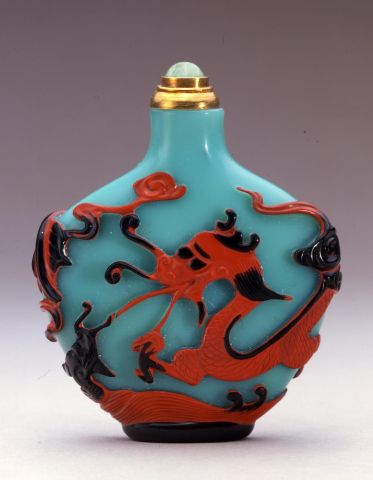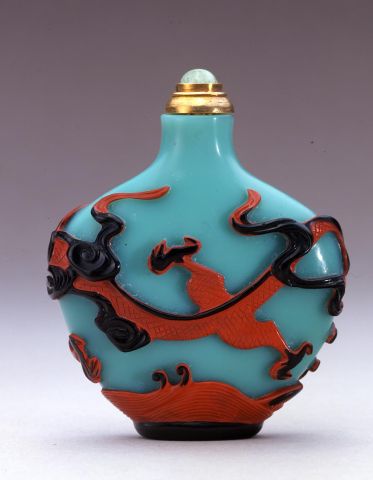

Bottle ID: 00330
TURQUOISE W/BLACK & CINNABAR OVERLAY, DRAGONS
Date: 1780-1850
Height: 60 mm
Glass, of flattened shield shape with sloping shoulders, with a double overlay of black on opaque cinnabar-red on an opaque turquoise ground, continuously carved with a vibrant scaly dragon exhaling fire amidst scrolling clouds, above a young dragon emerging from frothy waves, the oval base also carved from the cinnabar-red and black overlay.
Similar Examples:
Hughes, Michael C. The Blair Bequest - Chinese Snuff Bottles from the Princeton University Art Museum, 2002, p. 153, no. 192.
Low, Denis, S. K. More Treasures from the Sanctum of Enlightened Respect, 2002, p. 170, no. 158.
Friedman, Pamela R. Lessing. Chinese Snuff Bottles from the Pamela R. Lessing Friedman Collection, 1990, p. 48, no. 27.
Provenance:
Robert Hall
Exhibited:
Annual Convention ICSBS Toronto, October 2007
Published:
JICSBS Autumn, 2004, Front and Back Cover
Despite being initially catalogued as a 'Yangzhou School', the author finds this to be a naive conclusion. Very few Yangzhou School bottles have dragons as their subject matter. This motif is much more common on bottles produced in Beijing, both inside and outside the Palace. A stylistically similar glass overlay bottle is illustrated in Holden, Rivers and Mountains Far from the World, pp. 34-35, No. 6, showing a single overlay of a cinnabar-red dragon over a milk white ground. Although the relief is higher on the Holden bottle and the design is tighter, the carvings of the dragons display considerable similarities. The likelihood of the Holden bottle being grouped within the Yangzhou School is minimal, leaving only the color combination of the above bottle as a pointer towards its inclusion in the Yangzhou School. Yangzhou was an area of glass production of objects, including snuff bottles, but not an area where glass was manufactured. There is no evidence to suggest that glass was made there, and it is likely that glass blocks were brought into Yangzhou from glass manufacturing areas such as Boshan, to be melted down and fashioned into objects such as snuff bottles. The same types of glass in the same colors are found on bottles from Beijing, with cinnabar-red and opaque turquoise being a favored combination of the early nineteenth century.
The above bottle makes use of an exciting combination of colors suiting the subject admirably.

 English
English 中文
中文